3 - Acoustics and
Mechanics
3.0
- Introduction
3.1
- Your woofer box
3.2 - Your woofer box at higher frequencies
3.3 - Wave diffraction at the cabinet edge
3.4 -
The LXmini woofer
3.5 - The woofer & tweeter combination in Design #3
3.6 - The LXmini tweeter/fullrange
========================================================================================
3.4
- The LXmini woofer
Fitz: Yes, my
woofer design is different from the LXmini. And that is because my
domestic partner does not like to have those two poles standing in our
living room. They look too industrial, too much like plumbing.
SL: What can I say. Taste
is in the eye of the beholder. My philosophy is: 'Form follows Function'.
The Bauhaus motto for design. A loudspeaker is a transducer to me:
electrical in, acoustic out. It's a machine. Though to me there is a
beauty in a well executed machine design.

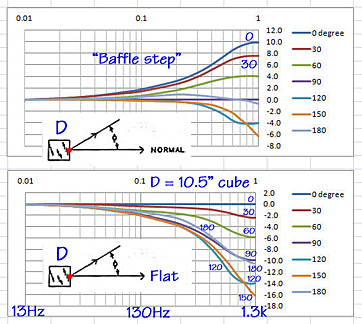
Fitz: So my box is
conventional and and has a familiar look, except for the tweeter on top. I
think it's cute.
SL: And like the majority
of conventional box speakers you have a baffle step in the on-axis
response. And after you have equalizes it to flat, then you have the
off-axis roll-off.
The LXmini woofer also has a baffle
step, but it is in the response pointing to the ceiling. The woofer is
mounted to point at the ceiling, but I listen at 90 degree off-axis, where
the response is flat. You can see this behavior in the graph for a
theoretical point source in the center of a cylinder. Since I operate the woofer
driver only below 1 kHz, it is acoustically small. Acoustic
measurements showed that I needed no eq to have a flat response. Only at
the low end, where the woofer rolls off at 12 dB/octave rate and is 6 dB
down at 60 Hz, did I apply some boost to extend the response to 45 Hz, -3
dB.
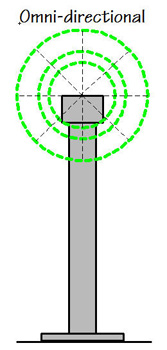
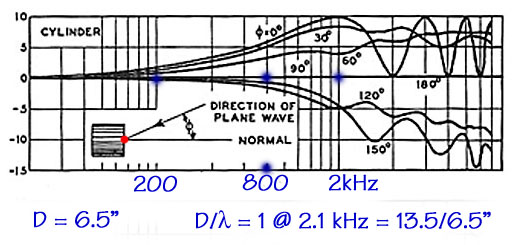
Fitz: Yes, as I said earlier I
will get more
bass output from the 8"
driver, than the LXmini can get from its 5"
driver. For the same
cone displacement I should get roughly (8"/5")2 =
2.56 times or 8.2 dB more output because of the larger cone area. I also
chose a sealed box, which means that the low end rolls off at 12 dB/oct.
The LXmini has its -3 dB corner at 45 Hz. I could equalize the 8"
woofer to have its -3 dB corner at (45 Hz) / [sqrt(2.56)] = 28 Hz and have
the same maximum SPL at 28 Hz as the LXmini has at 45 Hz. With DSP it is
easy to extend and flatten the low frequency response.
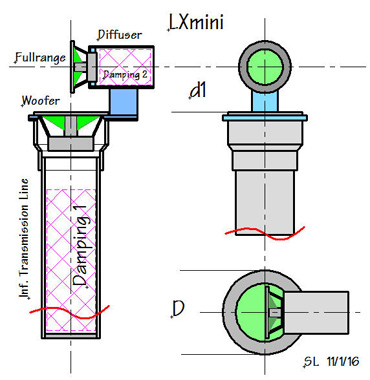
SL: Yes, and when you are
done, you need a stand for your woofer box to bring the tweeter to ear
level height. That stand could do more than just holding up the box. It
could provide additional air volume for a lower box resonance and thus
less equalization to extend the low end.
Fitz: I do not necessarily
put my speaker on a stand. It could sit on a bookshelf or a commode.
SL: Well, now you are
talking about a different animal. I have found that a speaker needs to be
free-standing for best performance, ideally a meter from large reflecting
surfaces. The LXmini, though, with its wide and spectrally neutral
dispersion of sound in all directions, does quite well even when placed
close to large reflecting surfaces.
Fitz: But your woofer is
beaming to the ceiling and has a baffle step in the vertical direction.
SL: Yes, in principle, and
that is why the diameter of driver and mounting adapter are kept as small
as possible. Rounding the ring edge has no effect, because the radius of
curvature is too small compared to the shortest radiated wavelength from
the woofer driver. Furthermore reflections from the ceiling are delayed
relative to the direct sound from the woofer. But radiation in vertical
and all other directions contributes to the reverberant sound in the room.
And that sound should have the same timbre as the direct sound.
The woofer pipe has a major benefit
over your box, even though their internal volumes are not greatly
different. The pipe gives me a conduit, an acoustic transmission line, for
the wave from the rear of the woofer cone to travel along. For example, if
a step is applied to the woofer, then the pressure wave travels from the
cone to the end of tthe pipe. Since the pipe is sealed, the wave is
reflected and travels back up to the cone. There it adds to the pressure,
which the cone was radiating into free-space. You can see the process in
the left picture below. The picture was derived from an electrical
transmission line model.


SL: Obviously you do not
want any reflected wave from the inside of the pipe to add to the direct
wave coming off the cone. That's why I put just the right amount of
stuffing into the pipe to completely smooth the frequency response. I can
see the effect of stuffing when I place a microphone within 1 cm of the
driver's dust cap, or when I look at the driver's terminal impedance.
Using tone-bursts I have measured the reflections from the end of the pipe
in front of the woofer cone to be 40 dB lower than the direct signal from
the cone. That is a 1% reflection factor or 40 dB return loss. Not bad for
someone like me, who worked with microwave transmission lines.
SL: There is one more big
benefit from using a pipe to contain acoustic energy and structure borne
vibrations: A pipe is extremely stiff and there is practically no spurious
radiation coming off its surface. For a box speaker it is very difficult
to keep the flat surfaces from not vibrating. You need lots of internal
bracing. And then you have the air borne sound energy inside the box,
which has not been turned into heat and which will in some form contribute
through the thin cone to what you hear. No wonder there is a generic sound
to the majority of box speakers.
Fitz: This is all good and
fine, but there are realities of life, over which I have little control.
There is a price for everything. I try to keep my priorities straight.
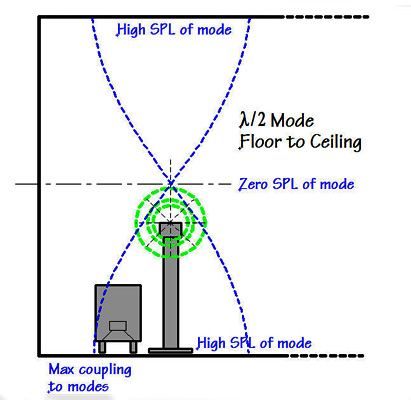
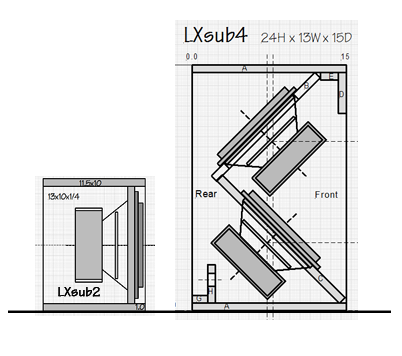
SL: The pipe brings the
woofer up and off the floor. That helps to reduce room
mode excitation. Room modes, or standing waves, have maximum pressure
on the large wall surfaces of a room, where the acoustic particle velocity
has to be zero. So when a box woofer is placed on the floor it couples
optimally to certain modes. It tends to couple optimally to all room modes
when placed in a room corner. This results in a booming and spatially
unevenly distributed bass in the room. For example, there could be a floor
to ceiling mode when the distance between them corresponds to half a
wavelength. For a 2.4 m ceiling height this would be at f = 344 / (2 x
2.4) = 72 Hz. If you measured at 1.2 m height in this room the
response from a loudspeaker it is likely to have a deep interference notch
in its frequency response if the woofer was seated on the floor. But if
the woofer was at 1.2 m height it would not sustain a 72 Hz floor to
ceiling standing wave and not produce a corresponding notch in the room
response.
Fewer than 10% of LXmini builders add
subwoofers to go lower in frequency or to get higher SPL. A pair of subs
reduces distortion from the LXmini woofer drivers, which have to work
pretty hard when by themselves in a stereo setup. A sub also gives an
enhanced sense of space when the recording has it. The LXmini+2
system uses the small and unobtrusive LXsub2, which is a U-frame
dipole woofer. A dipole excites the vertical and sideways room modes
much less, because it does not radiate in those directions.
Alternatively there is the LXsub4 with 10 dB higher output capability. It
is intended for professional, mixing studio applications as part of the LXstudio
system. Either sub uses the same
driver. The LXsub4 has 6 dB more output because it uses 2 drivers, and
adds another 4 dB more because the baffle is deeper.
3.5 - The woofer & tweeter
combination in Design #3
SL: It occurred to me,
Fitz, that I am spending valuable time of my life on explaining things to
you, which I have already dealt with on my website some time ago. You may
not have seen or studied the subjects or come to different conclusions. In
any case you already have made up your mind for Design #3 and want to find
out for yourself.
Just be sure to have studied Acoustics
and Hearing - 2.1.
Have fun with your project and
hopefully reach full satisfaction for yourself and for those you should
please!
3.6 - The LXmini tweeter/fullrange
SL: This has been
discussed on the LXmini pages.
*************************************************************************
|